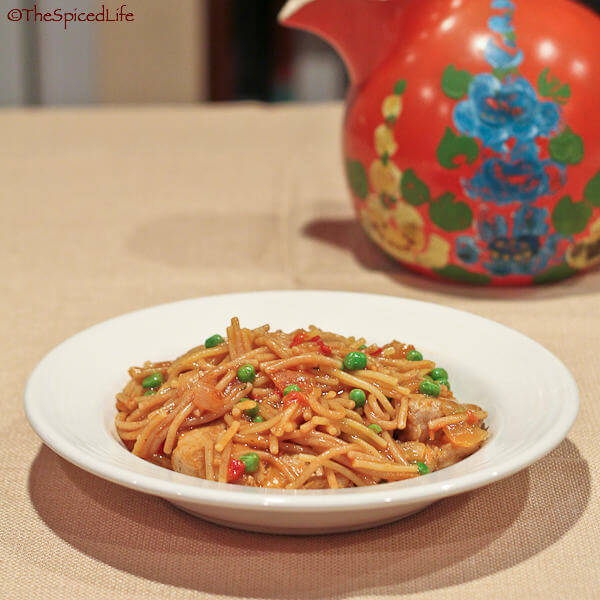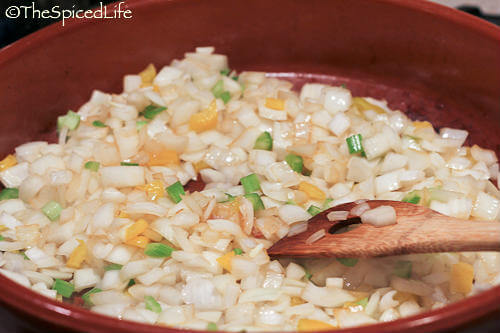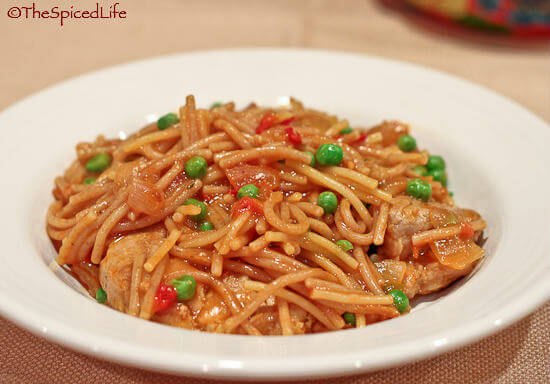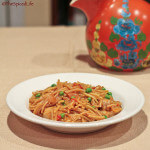
I swear I don’t do it on purpose. But somehow, whenever John leaves town for a conference, I seem to end up cooking something I know he would love. Sometimes I feel guilty about this. He is in Recife, Brazil for 8 days. I will let you draw your own conclusions about my guilt level this time.
Anyway, I went looking for a casserole to make with Alex on Sunday. And I learned something in the process. I would say that for many of us a casserole is something in a flat dish baked in the oven. But I can only guess that in Spain anything cooked in a cazuela, a clay pot “casserole” pan, qualifies, because I found the inspiration for this recipe under casseroles in Janet Mendel’s My Kitchen in Spain: 225 Authentic Regional Recipes, but it cooks completely on the stovetop. It looks like a baked spaghetti, but in reality is more like a paella made with noodles (and is therefore much simpler and quicker than paella, which relies on rice that slowly absorbs liquid and expands).

The recipe starts with browning pork in a terra cotta cazuela (such as this one) and then sautéing onions, peppers and garlic. I had limited peppers, so I added some celery for crunch (which I did not bother putting in the recipe) and then I also added some imported roasted piquillo peppers a little later in the process to boost the pepper flavor. For those wondering if the terra cotta cazuela makes a difference I will say this: I would not let a lack of the cazuela prevent you from making this, but I will also say that the aroma of the cooking dish was delicious and quite distinct, even early in the process.

One of the unusual aspects of this recipe is that the noodles cook in the dish, not separately. (Alex was totally entranced by this fact.) So you will bring the liquid in the cazuela to a boil before adding the broken spaghetti or fideos. This saves a step and allows the noodles to absorb all of the scrumptious flavor from the aromatics, tomatoes and smoked paprika and saffron–so a double win! (A quick note: I believe broken angel hair or vermicelli would be closer to authentic fideos, but Mendel said spaghetti would work and I had some farro spaghetti I wanted to use, so I used it.)

Just be smarter than me and remember to mix the peas in sooner! Although, on the other hand, if you strongly prefer your peas barely cooked, like us, maybe it is better to leave them until last and just sprinkle them on top?


- 1/2 cup (about 1/4 lb) cubed smoked Spanish chorizo
- 1 1/2 lbs of pork chops or pork tenderloin, sliced into bite sized sized pieces (I used tenderloin as it was what I had)
- salt and pepper to taste
- 3 T extra virgin olive oil
- 2 medium-large onions, chopped
- 1 bell pepper, chopped
- 5 roasted piquillo peppers, chopped
- 3-5 garlic cloves, minced
- 1 1/2 cups dry white wine, divided
- 1/4 t dried thyme (I used a mix of fresh and dried, use what you have)
- 2 medium-large tomatoes, peeled, chopped (I used frozen)
- 2 bay leaves
- 2 1/2 t smoked Spanish paprika (pimentón-I use dulce, i.e., not hot), divided
- 1 pinch of saffron
- 4 cups water, divided
- 12 oz angel hair, vermicelli or spaghetti, broken into quarters (you are aiming for 1/2-inch pieces, but I found that too much of a pain)
- 1 10-oz bag of frozen peas
-
Sprinkle the pork with salt and pepper on both sides and let sit for 5 minutes.
-
Heat the cazuela, starting with a low heat. Increase the heat gradually to medium to medium high, adding the oil when it gets hot.
-
First brown the chorizo, allowing some fat to render out and flavor the oil. When it is browned, remove the chorizo to rest in a bowl.
-
Next brown the pork--in batches if necessary to prevent steaming. Remove the pork to rest in a bowl--you can add it to the chorizo if you wish.
-
Add the onions with a pinch of salt and let cook for about 5 minutes. Then add the bell pepper, garlic and roasted pepper. Add another pinch of salt and let cook, stirring occasionally, until the onions are starting to brown.
-
Deglaze the pan with 1/2 cup of white wine. Cook until all the liquid boils off.
-
Add 1/2 teaspoon of paprika and let it roast in with the aromatics until fragrant, 30-60 seconds. Then add the tomatoes with a pinch of salt, the thyme and bay leaves. Bring to a boil and let the tomatoes cook until they are reduced and thickened, about 15 minutes.
-
While the tomatoes are cooking, measure out 1/2 cup of warm water and mix in the pinch of saffron and 2 teaspoons of pimentón.
-
When the tomatoes have reduced, add the paprika-saffron water, as well as another 3 1/2 cups of water and 1 cup white wine. Also add a pinch of salt. Mix everything in well, and then add the chorizo and pork back into the pan, with their accumulated juices.
-
Bring to a boil. Add the noodles and stir them in to distribute evenly and make sure they are all (mostly) covered with liquid. Let boil on medium to high heat for 5 minutes. Stir again and reduce the heat to low (but not all the way low) to maintain a very gentle boil.
-
After 5 minutes, stir in the peas. Let gently boil, uncovered, for another 15 minutes--do not stir again.
-
The dish is done when the noodles are tender. The dish should be moist, even juicy, but it should not remind you of a stew. Turn off the heat and let the casserole rest another 5 to 10 minutes before serving.
As always, affiliate links were used in this post, but only to link to items I would be linking to anyway.
I’m pretty sure i prefer this version of a casserole to the majority of the traditional American ones!! So much great flavor from the smoked paprika! It’s one of my favorite spices.
I like stovetop versions of baked things like this. We have a favorite stovetop lasagna that’s kind of free-form and delicious. One pot meals are so great!
This looks really good! Really looking forward to making this probably the week of Thanksgiving.